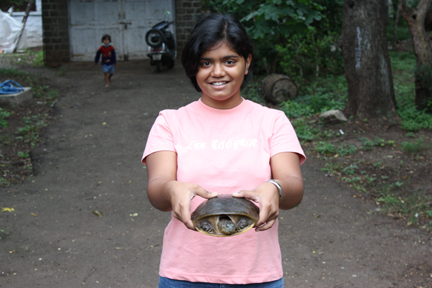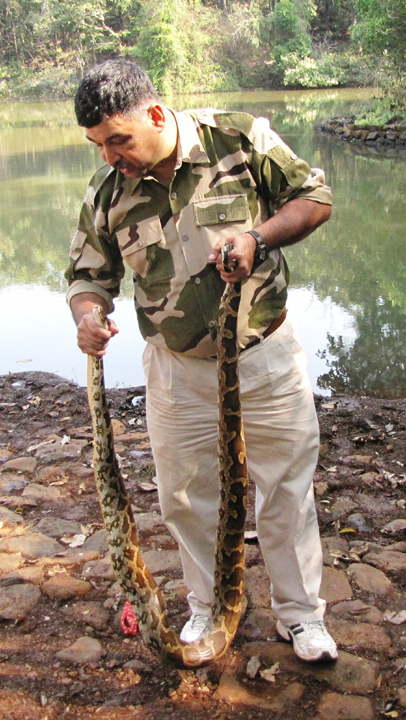Green Defenders
REPTILE RESCUE SQUAD - FLAPSHELL TURTLE
by
Aditi Baindur
If you are a tortoise and go for a very long walk on the CME campus far from your home, you may very soon find that you are back where you started from and named ‘Myrtle’ on top of that.
It was during the summer holidays last year that my Dad got a call at office from Bhattacharya Uncle. His daughter Shreya had found a tortoise in the garden. What, he asked, should be done? Naturally, Dad felt, it had to be restored to its habitat.
He picked me up, our tortoise books and we soon reached Bhattacharya Uncle's bungalow adjoining Holloway School. The turtle was in the lawn surrounded by Shreya and Priyansh, Bhattacharya Uncle's kids and Shrey Kamoji. It had withdrawn itself into its shell.
The back was coloured “muddy-shoddy, grey, brown, black, ochre”. It had three black stripes on its head.
I picked it up and turned it over. We saw that had got flaps to hide its legs under and realised that this was the Indian Flapshell Turtle or Lissemys punctata.
Now the turtle struggled to be put down. No sooner had this been done than its knobby, ridgy sleg with claws emerged and it scurried away along the lawn but was repeatedly recaptured while we pored over our books. We wanted to know why the turtle was wandering
so far from the CME lakes. Our handbook by J.C. Daniels had this to say -
“the adults and young make long journeys during the rainy season, which is probably the reason for the species being so widespread….”
Indian Flap-shell turtles are the “aam janta” in the turtle community of CME and occupy the four lakes and the river. They are also found amongst the reed-beds, ponds, quarries and marshes and the 2 km long rowing channel. The nearest water body or marsh
to Bhattacharya Uncle's house is more than a kilometer away.
The turtle had crossed roads, houses, gardens, fences, ditches and braved the dangers of stray dogs and turtle-eating people to land up where it did! If allowed to roam free, it would head deeper and deeper into the CME campus and surely would be killed.
Shreya asked ‘is it a boy or girl’? Since it is nt easy to identify the sex of a turtle just by looking at it, the children decided, (two girls both older vs two boys both younger), that it looked feminine and soon names for ‘her’ were being proposed. It
was decided that her name was actually “Myrtle” and that she would be a very good pet! Undying vows were made to look after the creature if only they could have it please, pleeassee...
Mindful of what the parents would have to say to this, Dad pointed out that Myrtle fed on shrimps, insects and worms from within the water (they actually eat that and some vegetation too) and her family was probably missing her.
It was decided to restore Myrtle to her home. Everybody set out in our red Maruti van for the rear Nashik gate. There Myrtle was released at a suitable spot upstream into the marshes near the CTW lake. The last photo that we have of Myrtle is of a grinning
Shrey Kamoji holding the turtle last before its release. And the reason for that is, as soon as we set it on the ground some good seven-eight feet from the water’s edge, Myrtle became greased lightning and vanished before we could photograph her!
So Myrtle the turtle went back to tell tales to the grand-turtles with a new name to boot.

Shreya holding the Flapshell turtle that she found
Image credit - Ashwin Baindur
|
Green Defenders
REPTILE RESCUE SQUAD - PYTHON
by
Aditi Baindur
We went to Goa during our December holidays. The crowded, polluted beaches disgusted us and we went in search of the old historic Goa nestled under the foothills of the Western Ghats. We visited the Butterfly Conservatory of Goa in Ponda, where we saw the
amazing Southern Birdwing, Malabar Peacock and Clipper butterflies. We stayed in a suite on the first floor of our host Prasad Uncle's house (bed and breakfast type facility). They were very hospitable and we had a great time visiting the churches and sanctuaries
of old Goa.
The first day, Prasad uncle brought us a sumptuous dinner but said he was in a hurry to go as he had just received a call to rescue a python. Naturally, CME's own Reptile Rescue Squad immediately lost interest in dinner and accompanied him for the noble
deed. It was very exciting. Till now, we had only caught common snakes and we had never rescued a python before. Prasad Uncle drove with full speed through the deserted streets of Ponda. We arrived outside a walled compound with metal gate. There in a drain
along the wall was the snake hidden by the curious crowd.
The python was huge and half-filled the drain with its coils. Prasad uncle jumped fearlessly into the drain and pounced on the snake. With his left hand he gripped it behind the head and with his right hand and feet he pressed down the coils. The snake
struggled but Prasad Uncle's hold was like that of a wrestler - the python was immobilized. We fetched a large sack from the boot of Prasad Uncle's car and he began lifting the snake out shifting his right hand grip to prevent the python from coiling around
his arm or body.
The python was a female and weighed between 40 and 50 kg and was at least twelve feet long. Males are much smaller. This enables males and females to catch different-sized prey in the forest and they do not compete with each other. As it struggled it released
a musky odour. Uncle carried it home and kept the secured sack in a store-room. Two days later, we were to go to Bondla sanctuary where he planned to release it into dense forest.
We really admired Prasad Uncle's technique and confidence. East Goa being forested has many snakes and Prasad Uncle was called out almost every day, sometimes three or four times. The Forest Department had got tired of rescue calls after office hours and
Prasad Uncle and his friends provided a free unofficial Reptile Rescue Service in different parts of Goa.
But this was only the first of many rescues. Over the next two days, Prasad Uncle was called again and again to the same spot where he caught five more pythons, one by one. They were all males - probably the female python was ready to mate and the males
had been attracted by the musk. We helped him catch two of these males.
The next day, we took a car dickey full of pythons to Bondla and released them one by one. The female was released first and she immediately climbed up into a bamboo thatch nearby. She was huge, large and so much thicker than any of the bamboo shoots but
immediately vanished from sight - a perfect example of nature's camouflage. The male pythons were released twenty minutes apart at different locations - two of them vanished as a weaving ripple into a nearby pond while the others dispersed in different directions
into the forest. We really felt good that six endangered snakes were safely rescued from urban Ponda and released into the wild.

A male python being released by my Dad
Image credit - Nandan Kalbag
|